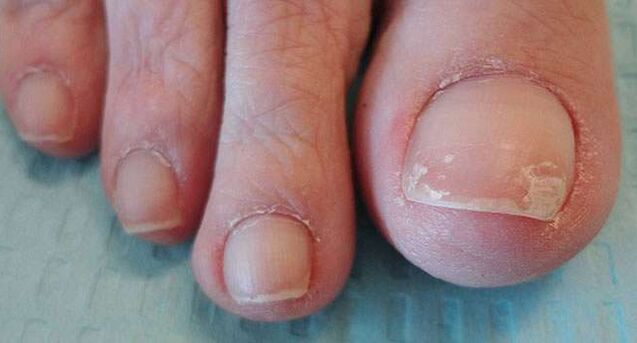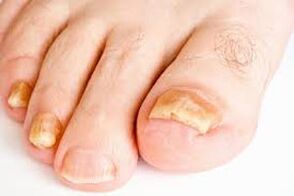A third of the world has delaminated and chipped nails and cloudy dishes.
This disease is called onychomycosis or onychomycosis. It can start at any age, spreads immediately and adapts well to different conditions.
%20and%20a%20toenail%20affected%20by%20fungus%20(right).jpg)
Causes of Onychomycosis
Fungal infection is easy. Infection can occur inPublic showers, beach and swimming pool.Loved ones and relatives infected with onychomycosis are at high risk of contracting onychomycosis if household items are used together.
The following prerequisites are required to cause the entry of pathogens into the body, in short, the cause of the emergence of fungi:
- Small skin lesions on the feet (corns, corns, small cracks and abrasions) caused by wearing tight shoes;
- Low immunity due to inflammation and infectious diseases;
- Vascular disease, impaired function of internal organs, resulting in poor blood circulation in the legs;
- Violation of safety precautions, i. e. going to public places without shoes, poor foot hygiene, trying on other people's shoes;
- Ignore profuse sweating of the legs and diaper rash.
important!
Onychomycosis starts on the thumb, and the virus can develop on the little finger later.
Which diseases can be considered as prerequisites?
High-risk groups include those whose skin cannot breathe due to wearing tight shoes all day. These include representatives of the working profession.
Having the following medical conditions can serve as a prerequisite:
- diabetes groups I and II;
- varicose veins;
- foot deformities;
- Clogged and obstructed blood vessels.
Today, various creams and varnishes are often offered for treatment, but they will be useless, since the cause may be internal diseases.
infection type

In total, there are more than five thousand species of fungibring problems. There is no single category.
The only thing is, there are two important signs that distinguish the disease. This is the location and type of pathogen.
important!
Infection can occur anywhere on the nail and is the main symptom of the disease. Externally, the affected plates vary according to the localization of the virus.
pathogen type
The etiology of this disease is varied, each has its own characteristics. These are important considerations when developing a treatment plan. The most common pathogens are:
- dermatophytes- This is Trichophyton rubrum and Trichophyton mentagrophytes, Epidermophyton flakes, etc. When infected with this type of fungus, yellowish or grayish spots form, the rest of the plate becomes cloudy, and free edges also darken. Often, the entire surface changes and ends up moving away from the bed.
- mold. This type is relatively harmless. It does not penetrate deep nail layers, thus only turning the board dark, boggy, gray, yellowish, brown. This shadow can affect the surface both partially and completely.
- Candida yeast。 They thin nails and help them fall off. Often, due to this pathogen, a white disease develops, which is characterized by inflammation of the stratum corneum. They cause severe pain, and a purulent discharge can be observed. If left untreated, the nails can thin, turn brown and leave the bed completely.
Location of diseases on arms, legs
The main forms of onychomycosis:
- side.The side nails are infected. Its color changes to gray, yellow and brown. The dishes started to get cloudy, chipped and peeled off.
- remote.This is the most common type of fungus. The infection begins at the free edge of the nail. The plate changes color to yellow, brown or gray. As time goes by, the losses get bigger and bigger. On the plate, the layering, shattering and clouding started. In this case, hyperkeratosis develops under the nail, and if the entire nail is affected, tissue dystrophy develops.
- near end.This form involves damage to the stratum corneum, which swells, becomes inflamed, turns red and changes its shape and structure. As a result, the roller separates from the plate and the nails chip, fade and deform. Plates can fall apart entirely due to neglected diseases.
- white finish.It usually appears on the thumb and sometimes on others. Superficially, it appears as white spots located all over the surface of the nail. In addition, the disease progresses and spreads to keratinized tissue. The spots can change color - from creamy white to green or yellow. The structure of the board is spongy and loose. If this form is not treated, the nail may collapse completely.
- Malnutrition is total.It covers the entire nail surface. This is the advanced degree of late or proximal fungi. The sheet thickens, becomes unnaturally shaped, and eventually fails completely.
fungal disease on nails photo
%20and%20onychomycosis%20(right).jpg)



Symptoms of mycosis
After an infection occurs, the fungus needs time to settle down. First, the disease affects the big toe, destroying the nail plate. Damage manifests itself in the following signs:
- thickened.Due to strong keratinization, the plates become thicker. In advanced cases, this can complicate treatment very much.
- Hue changes.In a healthy state, nails are translucent, and the translucent capillaries are pink. Infected individuals change color to black, brown, and yellow. A gap is created under the plate in which microbes and other pathogens grow.
- crumbling.Due to incomplete or absent treatment, the fungus begins to penetrate deeper layers of the board. As a result, it crashed. Onychomycosis can become a chronic condition if you don't treat it. As a result, the immune system is weakened, allergies set in, problems with internal organs begin.
How to independently judge and understand the disease?

The fungus affects one leg first, then the infection passes to the second leg. There is no need to procrastinate from this illness, and if you suspect it yourself and cannot identify the virus, always consult your doctor.
You can diagnose it yourself at home using certain methods.
Find out with potassium permanganate
A quick way is to dip your feet in a solution of potassium permanganate. Meanwhile, potassium permanganate stains healthy nails brown, while infected nails remain light in color.
The process is simple and doesn't take much time. Add a little potassium permanganate to a bowl of warm water. The solution should not be robust. Put your foot or hand in the liquid and wait about 10 minutes. This method is completely harmless. It should only be used if there is an allergic reaction to potassium permanganate.
Detection with iodine
Iodine is also commonly used to identify nail fungus. But this does not indicate the presence of pathogens. It can help get rid of other fungi, such as tinea versicolor.
Treat with tincture of iodine when the skin near the nail develops redness and peeling. Healthy skin does not darken under alcohol solutions, and areas affected by lichens will become very dark.
How is it diagnosed?
Today, various effective diagnostic methods are offered, the most reliable of which is probably a test for onychomycosis:
- Microbiological diagnosis.Microscopic examination is the most common method for detecting fungi and determining their type. It allows you to detect infection only in the structure of the nail plate or skin tissue. Obtaining biological material involves scraping infected cells from the area where the pathogen is located.
In the final and intermediate stages, mold spores, yeast cells and mycelium were found in the samples. This diagnosis can determine the accumulation and type of pathogen. The procedure itself lasts from 2 days to a month.
- linked immunosorbent assay. This analysis aims to identify fungi affecting nails and internal organs. It differs in that a venous blood draw is required to detect the disease, either in the morning or 4 hours after eating. The analysis requires no special preparation.
- Polymerase chain reaction test.Polymerase chain reaction is the best diagnostic method for infectious diseases. It has many advantages, such as speed, greater accuracy, and the ability to take any tissue sample. A feature of the method is believed to be the narrow focus. That is to say, for the diagnosis of onychomycosis, it is necessary to know exactly where to locate. A PCR test can reveal the type of fungus and its concentration in the body.
- luminescence research. This diagnosis is based on the transillumination of the skin affected by the pathological microflora with ultraviolet light. When examining a patient, a Wood lamp that emits ultraviolet light is used. Thanks to her, the products of life activity began to glow brightly. The type of pathogen affects the glow's shadows.
How to distinguish mycosis from bruises and other ailments?

At first, onychomycosis is easily confused with other conditions, such as lichens, nail bruises, or psoriasis.
It can be distinguished by darkening of the nail plate and the formation of yellow spots and streaks that become larger and deeper into the nail over time.
Onychomycosis develops smoothly compared to psoriasis. He gradually deformed the plate so that it fell off the bed. It distinguishes it from injuries, psoriasis, lichens and eczema, pain and bad smell.
health rules
The best treatment for fungus is prevention.Simple precautions can help prevent infection. First, they are needed by people who visit beaches, public pools, saunas, etc. In these places, you should always use a separate towel and wear a light slate.
If your feet sweat a lot, then you need to treat them with special methods, of which there are many today. Wearing shoes that are too tight or using someone else's shoes is not recommended. Wear shoe covers or socks when trying on shoes at the store. Be sure to pay attention to the hygiene of hands and feet, and dry them after washing.
When one of the family members has a fungal infection, he should have separate washcloths and washcloths. After he bathes, he must be treated with an antiseptic. Patient towels are regularly treated with a 5% chloramine solution, and clothing and towels are boiled with laundry detergent.
If an infection is suspected, the leg or arm should be soaked in hot water for about 10 minutes. Fungi die quickly at +50°C. Then apply an antifungal ointment to these areas.
in conclusion
Onychomycosis is an insidious and unpleasant condition, so it's important to monitor your toenails and fingernails and make sure you're taking preventive measures. If suspicious symptoms appear, it is best to seek medical attention and start treatment as soon as possible.
















